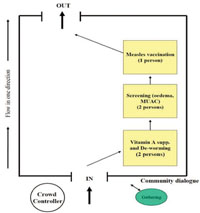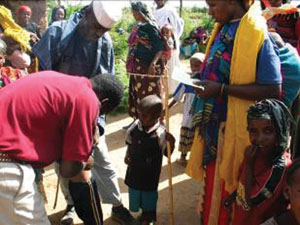Outreach site organisation
When selecting an outreach site, you should consider the adequacy of the space and suitability of the location for your work in the community. Whenever possible, you should involve the local community leaders in the selection of the site. It should be easily accessible to the community. The outreach site should preferably be in a building or on a veranda or under good shade. It should also have a clear banner/poster indicating that it is outreach site.
Can you give some examples of buildings that could be used as an outreach site?
After selecting the site, you need tables and chairs to be arranged in an organised manner so that you can provide the services. You should consider a number of important factors when arranging the flow of the service.
First of all you should consider what services are going to be provided. You need to organise the services in a logical order, from a service where a child is least likely to cry, to a service that may create discomfort to a child.
For example if there is measles immunization, it should be the last service, as children are likely to cry after the injection and may refuse other services. The figure below illustrates how the site and flow of services could be organised.

Since mothers may not remember the accurate age of a child in many rural communities, height-age is used as an objective way of excluding children older than 59 months from the service. Height-age is when the age of a child is estimated from its height. A child is expected to be 100 cm tall at the age of five years (60 months).
